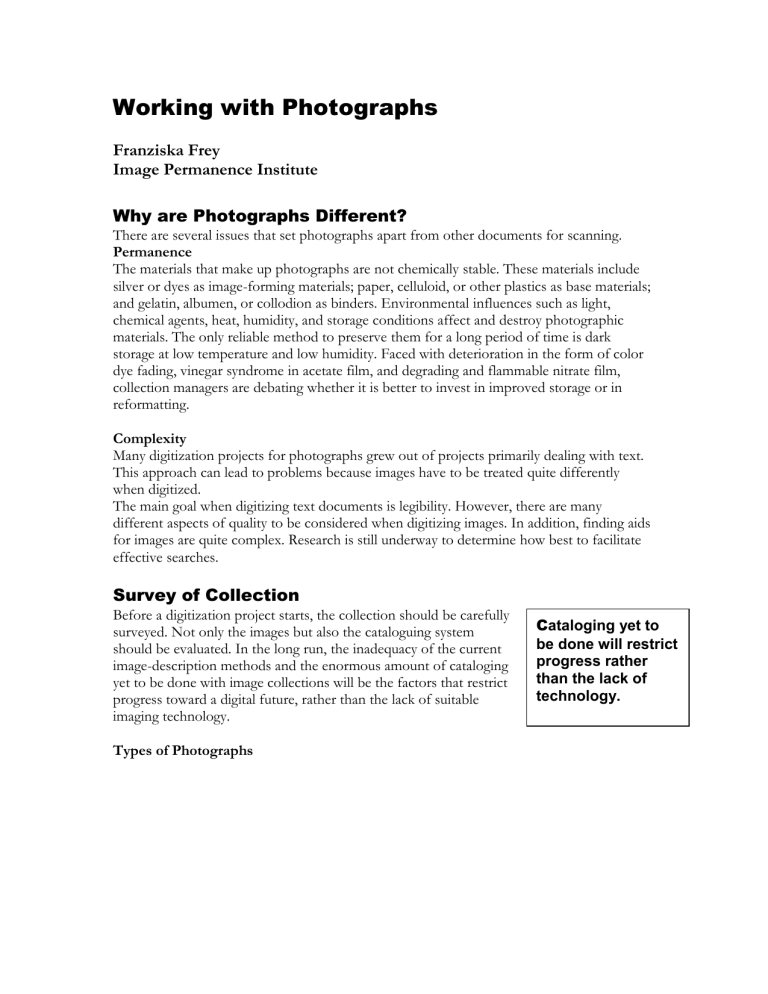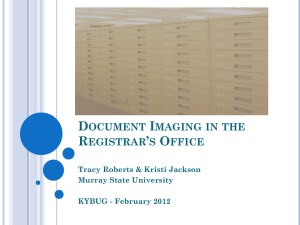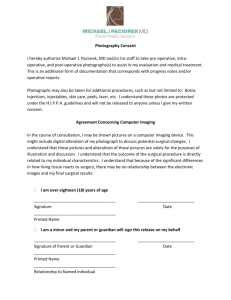Working with Photographs

Working with Photographs
Franziska Frey
Image Permanence Institute
Why are Photographs Different?
There are several issues that set photographs apart from other documents for scanning.
Permanence
The materials that make up photographs are not chemically stable. These materials include silver or dyes as image-forming materials; paper, celluloid, or other plastics as base materials; and gelatin, albumen, or collodion as binders. Environmental influences such as light, chemical agents, heat, humidity, and storage conditions affect and destroy photographic materials. The only reliable method to preserve them for a long period of time is dark storage at low temperature and low humidity. Faced with deterioration in the form of color dye fading, vinegar syndrome in acetate film, and degrading and flammable nitrate film, collection managers are debating whether it is better to invest in improved storage or in reformatting.
Complexity
Many digitization projects for photographs grew out of projects primarily dealing with text.
This approach can lead to problems because images have to be treated quite differently when digitized.
The main goal when digitizing text documents is legibility. However, there are many different aspects of quality to be considered when digitizing images. In addition, finding aids for images are quite complex. Research is still underway to determine how best to facilitate effective searches.
Survey of Collection
Before a digitization project starts, the collection should be carefully surveyed. Not only the images but also the cataloguing system should be evaluated. In the long run, the inadequacy of the current image-description methods and the enormous amount of cataloging yet to be done with image collections will be the factors that restrict progress toward a digital future, rather than the lack of suitable imaging technology.
Types of Photographs
C ataloging yet to be done will restrict progress rather than the lack of technology.
Photographs can be classified into two groups according to whether the image is viewed by reflected or transmitted light. The most important difference between the two is in dynamic range -- the difference between the lightest and the darkest areas of the image. Reflection prints of any type usually have a smaller dynamic range than negatives. Color transparencies have the largest dynamic range.
Negatives Negative collections especially profit from digitization since this makes them easily accessible. Millions of negatives are never used only because their image content is not readily available to the user. A printing process is needed to get a positive image. Therefore, not only the public but also often even the collection managers themselves don't know what a negative collection contains. It has already been proven that as soon as negatives are scanned and a positive image can be viewed, almost instantaneously their use has grown enormously. A huge number of older negatives are glass plate negatives. Choosing to digitize them reduces the risk of loss through breakage because they only have to be handled once.
Color Type Another way to classify images is by color type. Depending on the color type, images will be scanned in black-and-white or color.
Full Color-- Most of today's photographs are taken in full color. However, this trend only dates back to the mid-1960's. This means that the majority of collections will not include too many color photographs, a fact that will change when more color photographs come into archives and libraries.
Monochromatic Color -- A large number of photographs to be scanned will be monochromatic color (Reilly). Many 19th-century photographic print processes have characteristic colors,
e.g., the purplish-brown colors of albumen prints and the blue color of cyanotypes. Such colors help scholarly interpretation by conveying information about process and providing clues to the degree of deterioration the photographs may have suffered. Keeping this color information in the digital file is important since it is an inherent characteristic of the picture.
Black and White -- Black and white photographs taken in monochrome are either neutral black in color or have no significant visual information conveyed by the color of the images.
Primarily, these are negatives or modern silver-gelatin developed-out prints made in the 20th century.
Electronic Photography More and more, collections include images that never had a film original. Caring for electronic originals requires collection managers to pay attention to new specialties such as file formats, intellectual property law, high speed data transfer technology, and database management.
Formats
Image collections often will have a variety of formats, although certain formats (e.g., negatives, prints) can predominate. This variety requires the use of versatile scanning equipment.
Condition of Collection
A collection survey prior to scanning will help with decisions about what should be selected.
It also can lead to a plan to control conditions of the original collection in the future, for
example by providing better storage facilities or enclosure materials. Preparing a collection for scanning often includes an improvement of the physical conditions of the collection.
Size of Collection
The size of the collection also influences the scanning method and parameters. If the collection is very small, you can choose a time-consuming scanning method. A good example is the National Gallery in London, which scanned every painting using a special multispectral camera. Since the collection consists of only 3,000 paintings, it was possible to scan everything several times. This is not a possible solution for a collection that consists of thousands of images that will most likely not be rescanned within the near future. In addition, with larger collections the workflow has to be planned carefully.
Goals of Digitization
As the digitization of large collections is not likely to be attempted more than once a generation due to cost, educated decisions about the scanning and archiving processes are imperative. The term archival implies that all digitized images are not only optimized for current work flows and imaging devices but will continue to be usable on future, as yet unknown delivery and output systems (Frey & Süsstrunk, 1996; Frey, 1997; Frey &
Süsstrunk, 1997).
One of the big issues that institutions should consider prior to implementing a project is the anticipated use of their digital image collections. There is a consensus within the preservation community that a number of image files must be created from every photograph to meet a range of uses. First, an archive or master image should be created. The archival master file should represent the highest quality the institution can afford. It should not be treated for any specific output and should be left uncompressed or compressed in a lossless manner. It will also require an intensive quality review. From this archive file, various derivatives will be calculated.
These derivative files are meant to be used. Speed of access and transmission and suitability for certain purposes are the main issues to consider in the creation of these derivative files.
Scan from Duplicate or Original?
A decision has to be made whether to scan from the original or a duplicate. There are advantages and disadvantages to each approach. Because every generation of photographic copying involves some quality loss, using intermediates immediately implies some decrease in quality. Intermediates may also serve some other purposes, however; for example, they might serve as masters for photographic references copies or as preservation surrogates.
This leads to the question of whether the negative or the print should be used for digitization, assuming both are available. Quality will always be best if the first generation of an image (i.e., the negative), is used. However, there may be big differences between the negative and the print, mainly in the domain of fine-art photography. The artist often spends a lot of time in the darkroom creating the print. The results of all this work are lost if the negative, rather than the print, is scanned. The outcome of the digitization will be disappointing.
Quality Control
Subjective Visual Inspection
The best approach to digital image quality control includes, on the one hand, subjective visual inspection and, on the other hand, objective measurements performed in software and on the digital files themselves. Efforts should be made to standardize the procedures and equipment for subjective evaluation.
In most cases the first evaluation of a scanned image will be made by viewing it on a monitor. The viewer will decide whether the image on the monitor fulfills the goals that have been stated at the beginning of the scanning project. This is important because human judgment decides the final acceptability of an image.
Looking at images and judging their quality has always been a complex task. The viewer has to know what he/she is looking for. It should be emphasized that subjective quality control must be executed on calibrated equipment in an appropriate, standardized viewing environment
As the image is viewed on the monitor, defects such as dirt, half images, skew, laterally reversed images, and visual sharpness can be detected. In some cases it might be necessary to go back and redo the scanning.
Evaluating Digital Image Files
On the other hand, objective image quality parameters must be employed. You can accomplish this by scanning special targets and evaluating them in specialized software
(Gann, 1999; Holm, "Survey," 1996).
The targets and software to evaluate them are not just for vendor checking – they serve to guarantee the long-term usefulness of the digital files and to protect the investments of the institutions.
Image Quality Framework
When looking at image quality, the whole image processing chain has to be examined (Holm,
"Factors," 1996). Besides the scanning system, you also need to look at compression, file formats, image processing for various usage, and system calibration. Image quality is affected by the sequence of applying different image processing steps, including compression. Image processing done before storing the images can affect the quality of future processing. For example, it is recommended not to sharpen the archival master file before storing.
Each of the main image quality parameters needs special targets for the different forms of images (e.g., prints, transparencies). The targets should consist of the same material as the materials that will be scanned -- photographic film and paper.
These targets are a vital part of the image quality framework. After targets are scanned they are evaluated with a software program. Some software components exist as plug-ins to fullfeatured image browsers, others as stand-alone programs.
However, it has to be clearly stated that some of the targets and the software to evaluate them are not yet commercially available. Targets can be incorporated into the workflow in various ways. Full versions of the targets might be scanned every few hundred images and then linked to specific batches of production files, or smaller versions of the targets might be included with every image. As more institutions initiate digitization projects, having an objective tool to compare different scanning devices will be more and more important.
Tone Reproduction
Tone reproduction is the single most important parameter for determining the quality of an image. If the tone reproduction on an image is right, users will generally find the image acceptable, even is some of the other parameters are not optimal. Capture and display must occur for the concept of tone reproduction to exist. This means that an assumption must be made regarding the final viewing device. Three mutually dependent attributes affect tone reproduction: the optoelectronic conversion function (OECF), dynamic range, and flare.
The OECF shows the relationship between the optical densities of an original and the corresponding digital values of the file. Dynamic range refers to the capacity of the scanner to capture extreme density variations. The dynamic range of the scanner should meet or exceed the dynamic range of the original. Flare is generated by stray light in an optical system. Flare reduces the dynamic range of a scanner.
Color Reproduction
Several color reproduction intents can apply to a digital image. Perceptual intent, relative colorimetric intent, and absolute colorimetric intent are the terms often associated with the
International Color Consortium (ICC). Perceptual intent is to create a pleasing image on a given medium under given viewing conditions. Relative colorimetric intent is to match, as closely as possible, the colors of the reproduction to the colors of the original, taking into account output media and viewing conditions. Absolute colorimetric intent is to reproduce colors as exactly as possible, independent of output media and viewing conditions. Most of the available solutions for measuring and controlling color reproduction are geared towards the pre-press industry. However, when an image is scanned for archival purposes, the future use of the image is not yet known. Operator judgments regarding color and contrast cannot be reversed in a 24-bit RGB color system. Any output mapping different from the archived image's color space and gamma must be considered. Nevertheless, saving raw scanner data can create problems if the scanner characteristics are not well known and profiled.
One of the decisions is which color space to use. A color space is a geometric representation of colors in space, usually of three dimensions. The reason for the three dimensions is the human visual system that has three independent receptors and is therefore a three dimensional system. The most important attribute of a color space in an archival environment is that it be well defined. Furthermore, keep in mind that there is more than one solution to the problem. The right color space depends on the purpose and the use of the digital images (Süsstrunk, Buckley & Sven, 1999).
Resolution
A review of past digital projects has shown that people are most concerned about spatial resolution. This is not surprising, because of all the weak links in digital capture, spatial resolution has been the best understood by most people.
Technology has evolved, however, and today reasonable spatial resolution is neither extremely expensive nor does it cost a lot to store large data files. Spatial resolution is the parameter to define detail and edge reproduction in an image. Details can be, for example, single hairs in a portrait. A good edge reproduction is critical for the visual sharpness of an image. Spatial resolution of a digital image, i.e., the number of details an image contains, is usually defined by the number of pixels per inch (ppi).
The higher the number of pixels per inch, the more fine details can be transferred from the original image to the digital file. To find the equivalent number of pixels that describe the information content of a specific photographic emulsion is not a straightforward process.
Format of the original, film grain, film resolution, exposure, and processing techniques have to be taken into consideration to accurately determine the actual information content of a specific picture.
The best measure of detail and resolution is the Modulation Transfer Function (MTF). The
MTF is a graphical representation of image quality that eliminates the need for decision making by the observer.
Noise
Noise refers to random signal variations associated with detection and reproduction systems.
In conventional photography, noise in an image is the graininess that can be perceived. It can be seen most easily in uniform density areas. Noise is an important attribute of electronic imaging systems. Standardization will assist users and manufacturers in determining the quality of images being produced by these systems. Test results for noise are twofold. First the noise level of the system can be determined, indicating how many bit levels of the image data are actually useful.
Second, for image quality considerations, the signal-to-noise (S/N) ratio is the important factor to know. S/N evaluations show the effect of random noise on scan quality. Random noise, rather than bit-depth, is the primary limiting factor of the tonal resolution of the scanner. The test can consist in scanning a grayscale target twice. The two scans are subtracted and the standard deviation of the result is examined. The subtraction should remove all non-noise components (this is the image information) and the standard deviation is a good measure of random noise (Gann, 1999).
Costs
Budget Items
There are a variety of costs to consider (Puglia, 1999):
Selection
Preparation
Cataloging/Description/Indexing
Preservation/Conservation
Production of Intermediates
Digitization
Quality Control of Images and Metadata
Network Infrastructure
Ongoing Costs of Maintenance of Images and Data
Initial Costs
Digital conversion accounts for approximately one-third of the initial costs. Other costs, primarily those connected to cataloging, administration and quality control, account for the remaining two-thirds.
Ongoing Costs
Often, projectplanningandbudgetingstopsafterthecreationofthedigitalassets.However,an important part of the budget involves the costs for refreshing and migration and for the support of systems. This all can be put together under the umbrella of digital asset management.
It is difficult at this point in time to come up with exact numbers for this process. However, since both the archival community and the graphic industry are taking this approach, more and more real numbers will be available soon. Currently, it is estimated that 5% to 10% of the initial costs per image must be budgeted on a yearly basis to maintain the images into the future, even though migration and file conversion are not done on a yearly basis.
In-house vs. Outsourcing
Many pilot projects with image collections have been used to build up an in-house scanning facility. Although this is feasible for a small project, in a many cases it will be better and necessary to establish a good relationship with a vendor and outsource the whole imaging process. Even this approach requires a good knowledge of the imaging process, because all the parameters for imaging and building the system will have to be established by the institutions themselves. As the chapter on vendor relations emphasizes, it is very important to establish a good relationship with the vendor.
Conclusions
Many of the problems arising from the need to scan for an unknown future use are not yet solved, and there is a great deal of uncertainty about how to proceed. Those responsible for some of the large digital reformatting projects report the same problem: Rapid changes in technology make it difficult to choose the best time to set up a reformatting policy that will not be outdated tomorrow.
If institutions fail to communicate their
The lack of communication between the technical field and institutions remains a formidable obstacle. Both institutions and needs they won't obtain tools for special applications.
industry are interested in a dialogue, but there is no common language. It cannot be emphasized enough that if institutions fail to communicate their needs to the hardware and software industries, they will not obtain the tools they need for their special applications. Archives and libraries should know that they are involved in creating the new standards. Today, it seems that whoever is first on the market with a new product is creating a de facto standard for competitors. Furthermore, time to create new standards is very short; industry will not wait years to introduce a product simply because people cannot agree on a certain issue.
A digital project cannot be looked at as a linear process in which one task follows another.
Rather, it must be viewed as a complex structure of interrelated tasks in which each decision has an influence on another one. The first step in penetrating this complex structure is to thoroughly understand each single step and find metrics to quantify it. Once this is done, the separate entities can be put together in context. We are still in the first round of this process, but with the benefit of experience gathered from various digital projects, we are reaching the point where we can look at the complex system as a whole.
Sources
Arms, Caroline, ed. Enabling Access in Digital Libraries. Washington, DC: Council on Library and Information Resources, 1999.
Ester, Michael. Digital Image Collections: Issues and Practice. Washington, DC:
Commission on Preservation and Access, 1996.
Frey, Franziska. "Digital Imaging for Photographic Collections: Foundations for
Technical Standards," RLG DigiNews (December 1997).
[Online] www.rlg.org/preserv/diginews
Frey, Franziska and James Reilly. Digital Imaging for Photographic Collections: Foundations for
Technical Standards (November 1999). [Online] www.rit.edu/~661www1/sub_pages/frameset2.html
Frey, Franziska and Sabine Süsstrunk. "Color Issues to Consider in Pictorial Image Data
Bases." Proceedings IS&T's Fifth Color Imaging Conference, pp. 112-15. Scottsdale, AZ, November
17-20, 1997. ------. "Image Quality Issues for the Digitization of Photographic Collections."
Proceedings IS&T's 49th Annual Conference, pp. 349-53. Minneapolis, MN, May 19-24, 1996.
Gann, Robert G. Desktop Scanners. Upper Saddle River, NJ: Prentice Hall, 1999.
Holm, Jack. "Factors to Consider in Pictorial Digital Image Processing," Proceedings
IS&T's 49th Annual Conference, pp. 298-304. Minneapolis, MN, May 19-24, 1996.
------. "Survey of Developing Electronic Photography Standards." Standards for Electronic
Imaging Technologies, Devices, and Systems, SPIE, Critical Reviews of Optical Science and Technology
Series 61 (1996): 120-52.
Puglia, Steve. "The Costs of Digital Imaging," RLG DigiNews (October 1999). [Online] http://www.rlg.org/preserv/diginews
Reilly, James. Care and Identification of 19 th -Century Photographic Prints. Rochester, NY:
Eastman Kodak Publication, 1986.
Stephenson, Christie and Patricia McClung, eds. Delivering Digital Images—Cultural Heritage
Resources for Education.Los Angeles, CA: The Getty Information Institute, 1998.
Susstrunk, Sabine Robert Buckley and Steve Sven. "Standard RGB Color Spaces," Proceedings
IS&T's Seventh Color Imaging Conference (November 1999), Scottsdale, AZ.







